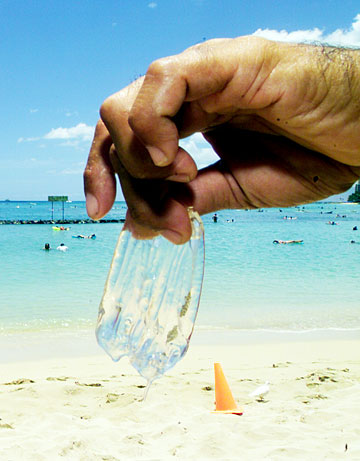
STAR-BULLETIN FILE / JULY 2003
Jellyfish like this one found on Waikiki Beach are among the hazards assessed as part of the new ocean-condition alert system, with a typical warning shown below.
|
|
BEACH BUMMERS
From jellyfish to high surf, a web site tells beachgoers where not to go for fun in the sun
THE CREATORS of a new beach safety Web site want to help reduce the number of drownings and perilous ocean rescues by educating people about where and when it's safe to swim.
National Weather Service information about incoming swells from open ocean buoys are run through a computer program developed by coastal geologists at the University of Hawaii's School of Ocean and Earth Science and Technology.
The result is advice for which beaches are best on a given day, especially for those unfamiliar with the ocean, said Honolulu Ocean Safety and Lifeguard Services Division Administrator Ralph Goto.
For now, the system informs bathers about lifeguarded beaches on Oahu, but its creators hope to expand to all islands.
Since spring, the accuracy of the system has been checked out by experienced lifeguards who compared the computer's daily projections with actual ocean conditions, Goto said.
Through the summer, fall and now winter-size surf, the accuracy of the system has been "amazing," Goto said. And if predictions are a little different from conditions observed by lifeguards, the Ocean Safety division can make the Web site conform to reality, he said.
"We want to get accurate information to beachgoers," Goto said, so they can make their own decisions about where to go. The "real-time" aspect of the system is a key point, too, he said.
The site automatically updates itself three or more times a day, based on new buoy information. It also includes warnings if jellyfish are present.
Charles "Chip" Fletcher, a UH coastal geology professor who worked on the program, said it's the first of its kind in the world.
"The No. 1 visitor death is drowning," he said yesterday. "We want to save lives."
The system isn't intended to keep all people out of the water, nor can it, Goto said. It could be compared to the system used at ski resorts to inform skiers of a slope difficulty.
Under "normal caution" conditions, represented on the Web site maps with a yellow square, ocean users should still be alert for changing conditions, underwater rocks and rough shore breaks.
As the guide moves through the "hazardous" (orange triangle), "very hazardous" (red stop sign) and "extremely hazardous" (black diamonds) conditions, more and more caution is urged.
Goto said he purposely didn't include a green, or "go," category, to remind people that there are hazards even on a calm day at a normally benign beach.
The site doesn't target experienced local ocean users, who already know conditions at their favorite places, and how to cope with them, Goto said. But it should help a local family that doesn't go to the beach that often pick a good one for a picnic with the kids, he said.
Since not every vacationer consults a computer before planning a day at the beach, the Hawaii Tourism Authority is looking at ways it might help connect visitors with the Web site, HTA chief Rex Johnson said yesterday. Possibilities under consideration include special television programming that goes to hotels or making the Web site part of a hotel concierge's tool kit, he said.
"We really like the program. It will be very beneficial to visitors and locals. It's a great idea," Johnson said.
Initial work on the project was funded by a lifeguards association and the state Department of Health, which keeps track of drowning deaths through its epidemiology division.
About half of the drowning deaths are visitors to the islands, said Health Department epidemiologist Dan Galanis.
Yesterday afternoon, the site recommended: Kailua Beach Park, Duke Paoa Kahanamoku Beach Park, Kapiolani Park Beach Center, Kapiolani Beach Park, Kuhio Beach Park, Sans Souci Beach and Ala Moana Beach Park.
In addition to reminding people that Hanauma Bay Nature Preserve was closed for its regular Tuesday closure, the site listed these beaches as hazardous to varying extents: Alii Beach Park, Ehukai Beach Park, Haleiwa Beach Park, Sunset Beach Park, Waimea Bay Beach Park, KeWaena Beach Park, Maili Beach Park, Makaha Beach Park, Nanakuli Beach Park, Makapuu Beach Park and Sandy Beach Park.
The homepage of the site has a "slideshow" showing examples of key beach and shore hazards and giving basic advice, such as "Always ask a lifeguard about hazardous conditions," or "Submerged rocks can cause injuries."
Users can pick maps of the North, South, Windward and Leeward coasts for an overview of conditions or refer to the list of recommended beaches for that day.

